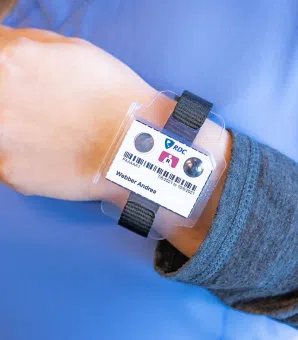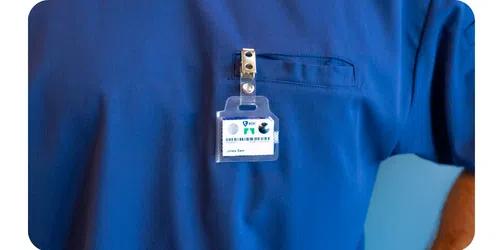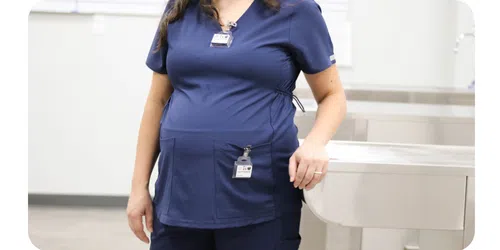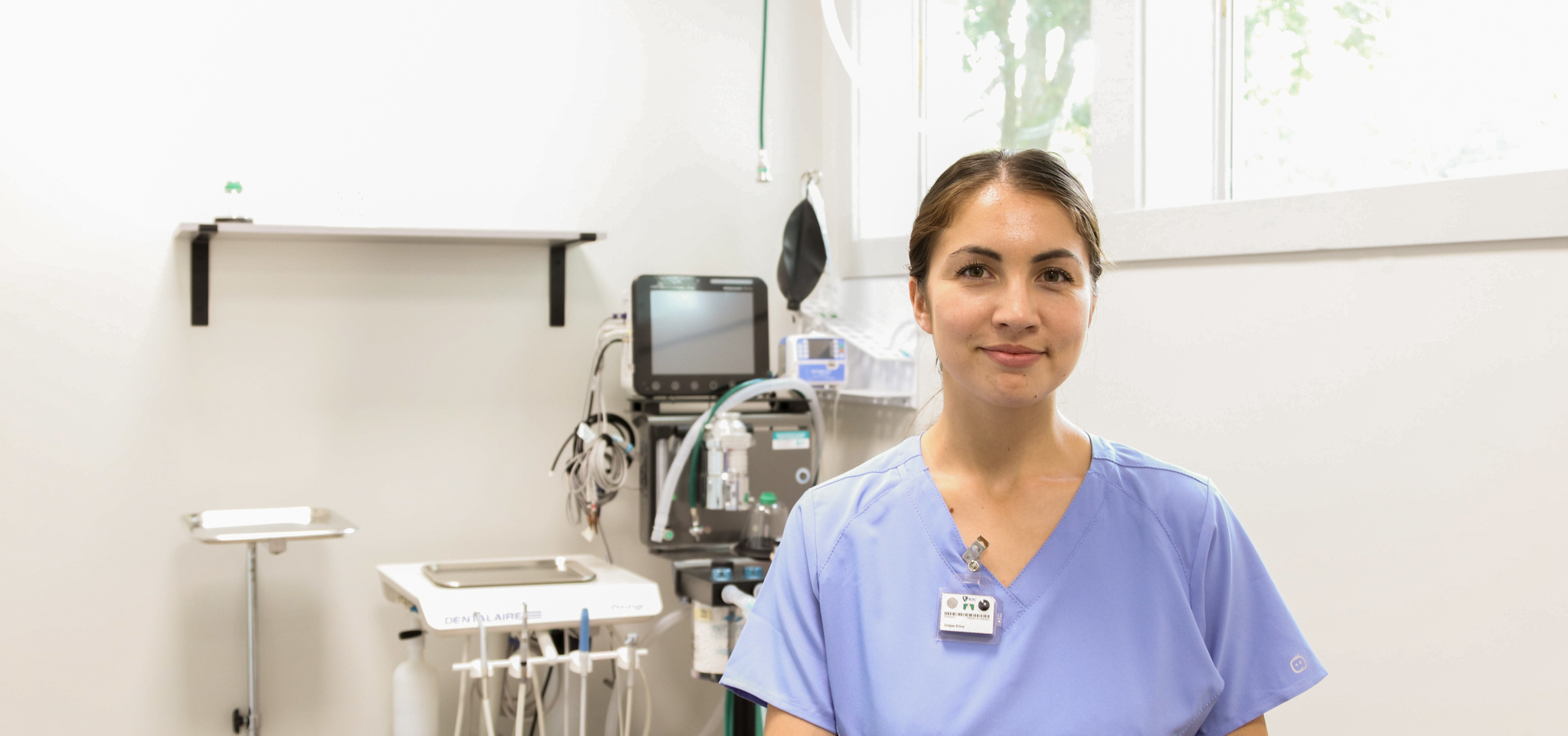
Dosimeter badge services for medical, dental, and veterinary businesses
Learn how Radiation Detection Company’s easy-to-use dosimetry solutions can boost the efficiency of your practice.
Working with, or near radioactive materials can be intimidating, but there are several things you can do to mitigate the risk. To keep employees safe, organizations must follow federal guidelines set by the US Nuclear Regulatory Commission (NRC), as well as all state regulations. Wearing a radiation dosimeter badge ensures you are not exceeding any radiation limits set by these guidelines.
Dosimeter badges are easy to use and can accurately report exposure received from all types of ionizing radiation that can cause external exposure. It’s important that every employee wears the correct dosimeter for the type of radiation they are working with and that they are wearing their dosimeter correctly. When used properly, a dosimeter can provide valuable information to the Radiation Safety Officer to help keep employees safe.
Anyone working with radioactive materials, or devices that emit x-ray radiation, should wear a dosimeter badge. A dosimeter is a cheap form of insurance that guarantees an employee is not exposed to high exposures that could leave an employer liable for injuries.
If an employee is likely to exceed 500 millirem in a year, individual personnel monitoring is required. The US NRC dose limit for occupational exposure for anyone over the age of 18 is currently 5,000 mrem. This limit applies to all radiation workers working with radioactive materials or in radioactive areas. (States may have other requirements in addition to the federal limits.)
Rules and regulations for the use and storage of radioactive materials apply to radiation workers. A radiation worker is defined as an employee 18 years of age or older that over the course of a year is likely to exceed 100 mrem. Radiation workers must be trained annually to keep themselves safe from radiation exposure. Minors working with radioactive materials may not exceed 10% of the annual dose limit for radiation workers.
Pregnant radiation workers have additional dose limits. Once a pregnant radiation worker has declared their pregnancy to their Radiation Safety Officer, they must be issued a fetal monitor to ensure exposure to the embryo or fetus does not exceed 500 mrem during the pregnancy. The fetal monitor is no longer required once the radiation worker declares that they are no longer pregnant.
A facility working with exposure levels that are under the federal and state limits may still elect to provide dosimeters to their employees. A radiation dosimeter badge can provide peace of mind to employees working with radioactive materials to ensure harmful radiation exposure does not occur.

Badges must be worn whenever working with or near radioactive materials or x-ray emitting devices. Areas where radioactive materials must be kept secure from non-radiation workers and must have the required signage for the materials present in that location. The Notice to Employees form must also be posted listing the responsibilities of the employer and employees. The Notice to Employees form can be obtained from the Agreement state where the facility is located. In the event that the facility is not located within an Agreement state, this form can be obtained directly from the NRC.
Dosimeters should be worn to best reflect the amount of radiation an employee receives. Badges are worn on the torso to accurately report the amount of exposure received to the body. Doses delivered to the organs are reported as deep doses. The doses delivered to the body that do not reach the organs are reported as shallow doses. Doses delivered to the lens of the eye are reported as eye doses.
Employees working in environments where they are likely to receive elevated exposure to their extremities should wear either a ring, or a wrist dosimeter. These dosimeter types only report dose received to the extremities, and as such do not replace the requirement for a dosimeter worn on the body. Extremities are not subject to the 5,000 mrem a year limit set by the NRC and may receive up to 50,000 mrem.
When choosing between a ring or wrist dosimeter, it’s important to evaluate the type of work an employee is performing. Employees working with x-ray radiation that may enter the radiation field with their hands, such as a vet holding an animal down during an examination, are typically good candidates for a wrist dosimeter. Employees working with low energy isotopes that may not be detected by a wrist dosimeter should consider a ring dosimeter that can be closer to the isotope to more accurately reflect the dose received. Before making your decision on the best dosimeter type, it’s also important to check your Radioactive Material License to see what dosimeter types have been listed that must be used.
Fetal monitors should be worn as close to the embryo or fetus as possible to best reflect the exposure to the embryo or fetus. This dosimeter does not replace the requirement of a radiation dosimeter badge for the pregnant radiation worker.

Shielding from lead aprons can be reported using EDE, or Webster calculations. If a single radiation dosimeter badge is worn while using a lead apron, applying a Webster 1 calculation will decrease the reported deep dose to the employee to 30% of the measured dose. It’s important that the dosimeter used for Webster 1 calculations should always be worn outside the lead apron to accurately measure shallow and eye dose.
A Webster 2 calculation can also be used to calculate the shielding obtained from wearing a lead apron using two dosimeters. When using this calculation type, one badge is worn on the outside of the collar of the lead apron, while the other badge is worn on the waist under the lead apron. The shallow and eye doses are calculated using the shallow dose delivered to the collar badge. The deep dose is equal to 1.5 the deep dose of the waste badge, plus .04 of the collar badge deep dose. Each dosimeter will be identified by either collar or waist. These wear locations are not interchangeable.
When receiving your dosimeters, a control badge will be included in the shipment. The control badge is designed to subtract transit, and background exposure your badges received while not being worn. This exposure will be subtracted from the personnel badges so that occupational exposure can be properly reported. All badges should be stored away from radioactive materials, or areas with elevated radiation levels to prevent exposing badges to radiation while not in use. While a designated storage place should help prevent loss of a badge, should an employee lose their dosimeter at any time during the reading period, they should immediately request a replacement badge.
Badges will need to be exchanged at a selected reporting interval, typically monthly, or quarterly. New dosimeters will be given to employees while the dosimeters from the previous interval should be returned to the dosimetry provider to be analyzed. All dosimeters, including the control, should be packaged and returned at the same time. This will guarantee all badges were exposed to the same background and transit radiation levels.
At RDC, exchanging badges is handled automatically. New dosimeter badges are sent before the previous wear cycle ends to ensure there is never a lapse in dosimeter wearing. Control badges for the area are included for free with each wear period to help with quality control and provide accurate measurements. After each set of badges are read, the results are available through MyRadCare for each employee to review. With accessories like badge clips, badge boards for storage, and online radiation safety training, RDC helps workplaces ensure they are following national and local safety requirements. Should you need any assistance, RDC also offers live support to help companies create the best plan for their needs.
Managing dosimeter badges doesn’t have to be a time-consuming activity; with RDC, the whole process becomes streamlined and pain-free. Sign up today or request a call with RDC to learn more about our NVLAP accredited dosimeter badge solution (NVLAP Lab Code 100512-0).
Learn how Radiation Detection Company’s easy-to-use dosimetry solutions can boost the efficiency of your practice.
